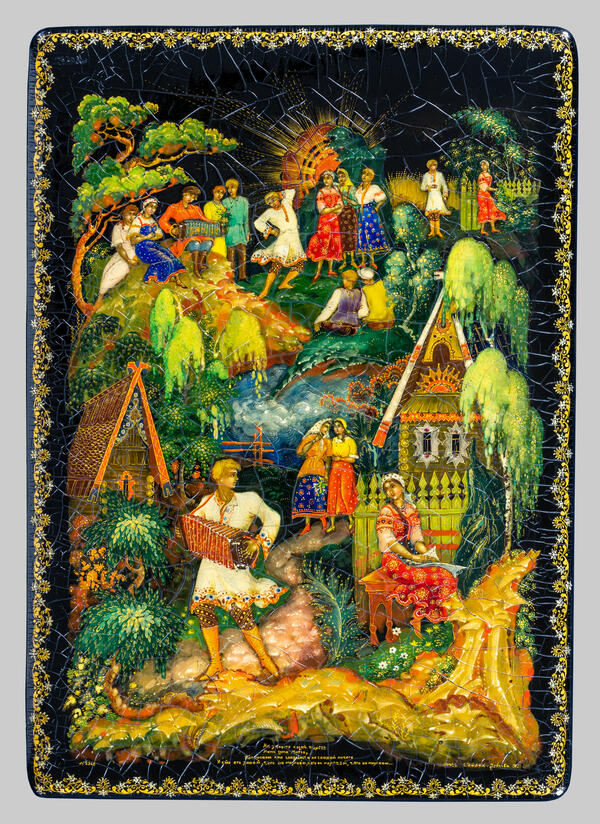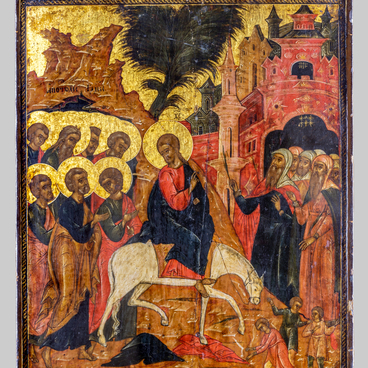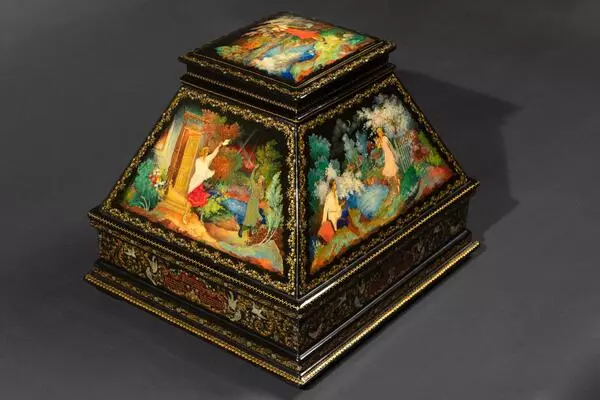Tamara Zubkova painted the miniature ‘Who Knows? ’ in 1946. In it, the artist accurately conveyed the new reality of the Stalin era. The miniature was inspired by a song of the same name based on a poem by Mikhail Isakovsky. In the song, a girl is thinking about a guy who is in love with her: ‘A guy walks by my house at sunset. He winks at me and says nothing. Who knows why he’s winking?..’ This song was very popular in the Soviet times.
The artist chose the vertical format of a casket to illustrate the song. She placed the main character not in the center, but in the lower part of the composition. The enamored accordion player is depicted in the foreground, which is why he looks bigger than the rest of the characters. Everyone else seems to be standing at the far side of a village street. However, this is all relative, as the space in the picture is more vertical than deep The accordion dances and farewell at the gate depicted in the upper part of the miniature are reminiscent of the following lines of the song: “When I come to the feast, he dances and sings, and as I say goodbye at the gate, he turns away and sighs. Who knows why he”s sighing?..”
The author paid a lot of attention to color. Repeating red and orange spots and rhythmic dissonances create a vivid compositional pattern. The huge red sun acts not only as a color dominant, but also as a source of golden light that covers the whole picture.
Tamara Zubkova came from a long line of Palekh icon painters. During Palekh’s difficult years, when naturalism dominated visual arts, she continued the traditions of the founders of lacquer miniature. She used the traditional Palekh icon painting techniques in this miniature, but made the landscape more realistic. The images of nature are full of life, just like in the works of the landscape painters of the old. Many of the artist’s works are full of poetry, music, and lyricism.
Tamara Zubkova made many versions of the “Who Knows? ” miniature with different compositions, but the miniature on display in the Palekh Museum is considered the best of them.
The artist chose the vertical format of a casket to illustrate the song. She placed the main character not in the center, but in the lower part of the composition. The enamored accordion player is depicted in the foreground, which is why he looks bigger than the rest of the characters. Everyone else seems to be standing at the far side of a village street. However, this is all relative, as the space in the picture is more vertical than deep The accordion dances and farewell at the gate depicted in the upper part of the miniature are reminiscent of the following lines of the song: “When I come to the feast, he dances and sings, and as I say goodbye at the gate, he turns away and sighs. Who knows why he”s sighing?..”
The author paid a lot of attention to color. Repeating red and orange spots and rhythmic dissonances create a vivid compositional pattern. The huge red sun acts not only as a color dominant, but also as a source of golden light that covers the whole picture.
Tamara Zubkova came from a long line of Palekh icon painters. During Palekh’s difficult years, when naturalism dominated visual arts, she continued the traditions of the founders of lacquer miniature. She used the traditional Palekh icon painting techniques in this miniature, but made the landscape more realistic. The images of nature are full of life, just like in the works of the landscape painters of the old. Many of the artist’s works are full of poetry, music, and lyricism.
Tamara Zubkova made many versions of the “Who Knows? ” miniature with different compositions, but the miniature on display in the Palekh Museum is considered the best of them.




